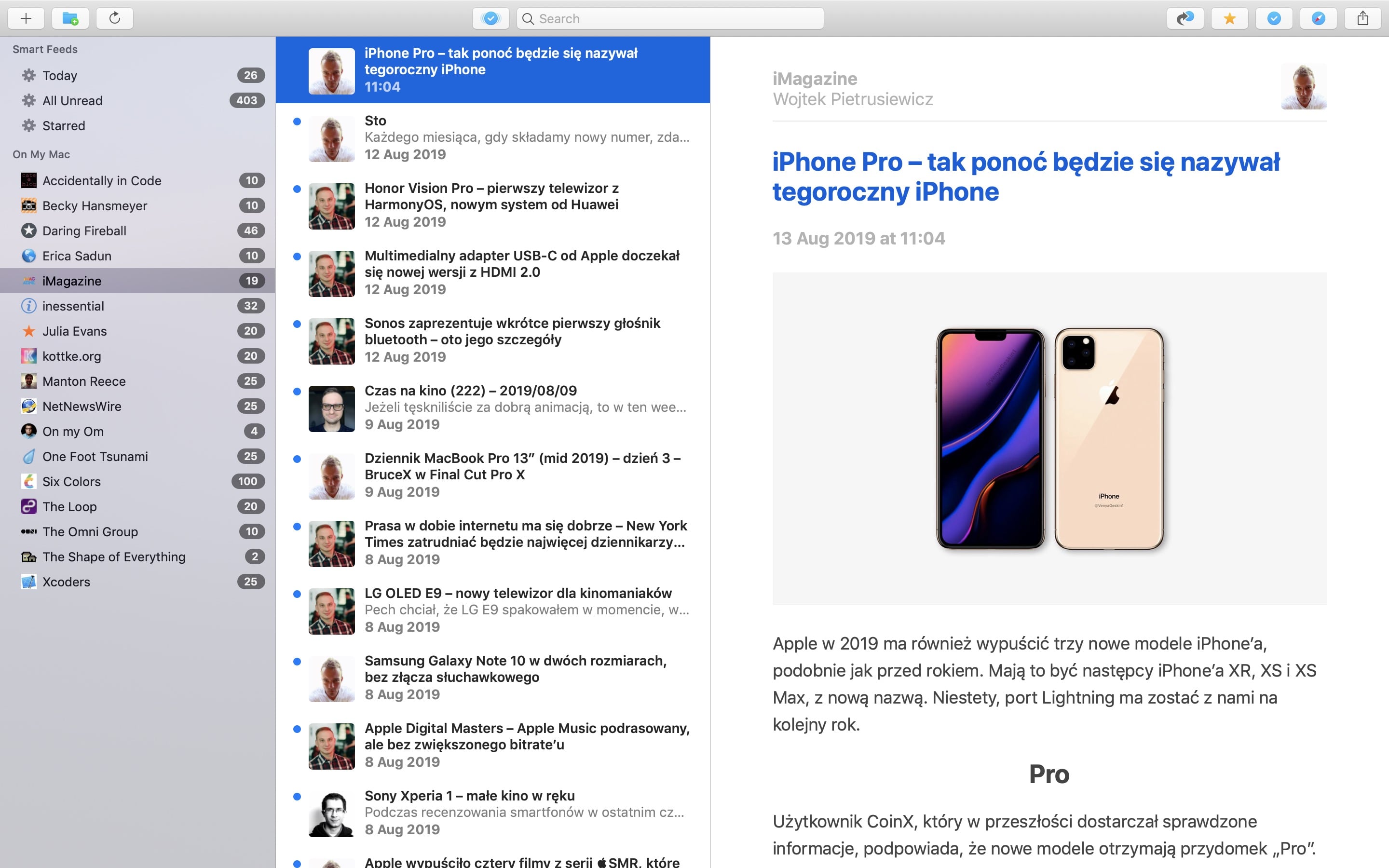

Mac OS X 10.6 (Snow Leopard)Īugust 28, 2009: Leopard’s successor, Snow Leopard, focused on expanding 64-bit architecture. In fact, Leopard featured so much new stuff that Apple even had to delay the initial release date to finish it all in time. Time Machine, Spotlight enhancements, and support for 64-bit apps arrive too. This time, Mac’s desktop changes significantly, with Dock, a new menu bar, and Stacks. October 26, 2007: Here comes Leopard, one of the most Mac-changing systems. During this time, Apple also switched to Intel’s processors, which made Tiger the first system operating on Macs with Intel chips. It featured Spotlight search, Automator, VoiceOver, and around 200 other improvements.
Netnewswire mac os tv#
Mac OS X 10.4 (Tiger)Īpril 29, 2005: Did you think Apple TV is pretty new? Well, guess what, it was born in 2005, with the release of Apple’s fifth operating system! Tiger was a pretty big update. Other than that, Panther adds 150+ new features, including Font Book, Xcode enhancements, and more. In fact, Safari was available on Jaguar but it’s the first release where it becomes a default browser.
:max_bytes(150000):strip_icc()/NetNewsWire-a74491e48cb1450e9fa3b697ef2ce623.jpg)
October 24, 2003: Meet Safari! The first official web browser made by Apple replaces Internet Explorer on Mac. Some of the apps born with this release continue living on Mac even today (for example, Address Book, which is now called Contacts). Mac OS X 10.2 (Jaguar)Īugust 23, 2002: The third release of Mac OS X added search to Finder (can you imagine it, Finder used to exist without it!) Jaguar also brings MPEG-4 support for QuickTime, a range of privacy features, and, for the first time, Accessibility API called Universal Access.

Puma arrived with a solid performance boost and a few other functional improvements such as simplified CD and DVD burning, new features in Finder, and more extensive printer support. September 25, 2001: As you might have noticed, the first generation of Apple’s operating systems was named after animals. Graphics improvements made Cheetah very slow, which prompted Apple to shift focus from visual experience to performance in the next release. Cheetah featured a water theme, which, according to Steve Jobs, "one wanted to lick when they saw it." Beauty comes at a cost, though. It’s a big step in the evolution of graphical interfaces, with 2D and 3D graphics support, granting an all-new visual experience. March 24, 2001: Aqua interface is born with Mac OS X Cheetah. Let’s recount the stories of all Mac OS X versions, up to the current macOS. The first ancestor of the macOS family was Mac OS X Public Beta released in 2000, followed by a public release of Mac OS X 10.0 in 2001. That’s when it became obvious Apple could grow to become a big player. The same year, Jobs returned to Apple and helped build the first Mac OS that could compete with Windows. In 1996, Apple purchased NeXT, the company Steve Jobs built after he had left Apple. The latter helped standardize the naming of Apple’s operating systems - macOS, iOS, tvOS, iPadOS, etc. Finally, Apple shifted to "macOS" with the release of macOS High Sierra in 2016. In the next four years, the OS X names were used. Mac OS X was the official naming through version 10.7, from 2001 to 2011. In fact, three terms were used at different times with reference to Apple’s operating system: Mac OS X, OS X, and macOS. No, they are essentially the same thing - just named differently. Is there any difference between Mac OS X and macOS? In this article, we guide you through the evolution of Apple’s operating system, from the first public release in 2001 to the latest macOS Monterey announced at WWDC 2021 on June 7. As Apple grew and strengthened the ecosystem through the years, macOS operating system version history evolved too. MomacOS is the operating system designed to run on Apple laptops and desktop computers. Try it out, unless you are dead set against a subscription.Tackle your tasks with Setapp app suite solutions. Given a choice between these, I'd go with ReadKit. It also works with some read-it-later services like Instapaper. They also are not on the subscription trend, and I think older versions become free, but the newest version requires payment to use, if I recall correctly. Reeder 5 is probably the most popular of the three, and is refined by time and multiple versions. You have to pay to try it, if that's the case. I don't think there is a "free trial" at all. It keeps you to one RSS service, I believe, and it is one price, one time.
Netnewswire mac os full#
Lire is awesome for pulling down full articles and for sites that link to other sites. I don't know if they made the old version unavailable. One price, for all apps, but a subscription, which turns some folks off. Plus, it's universal between iOS and Mac now. My favorite part about it is that it can connect to multiple services and the new version just added more. ReadKit just launched a new version, but was "born" as a Mac Client.


 0 kommentar(er)
0 kommentar(er)
